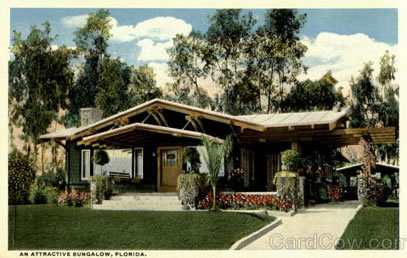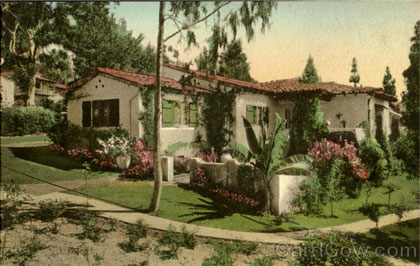
Bungalow Restoration
by Kevin Doherty
The restoration of a bungalow or Craftsman home has its share of challenges but the process is well worth it! The journey will render you more sensitive to good design, more appreciative of bungalow architecture, and grateful for the charm and character of your own historic neighborhood. Most importantly, you’ll gather a deeper sense of place and develop a profound sense of your house as your home.
Explore and Discover
The first step when approaching home improvement is to acknowledge that a learning curve exists before making any decisions regarding your project. The knowledge gained will be fundamental to your ability to have informed discussions with your hired help and to make wise choices at every level of the design and construction process. Begin by purchasing quality architectural periodicals pertaining to the style of your home and the scope of your project. A recommended resource for architectural books is Hennessey and Ingalls Bookstore in Santa Monica. A visit to historic homes and gardens in Southern California, such as the Gamble House, The Lummis Home, the Doheny Mansion and the Hollyhock House will further your education. Obtain a copy of your neighborhood's historic design guidelines and if you see homes in your area that you admire, ask the owners how they achieved their fine results. Through careful study and notetaking your aesthetic and architectural understanding will deepen, and a cohesive vision of your needs and how to address them will begin to emerge.
Architects, Designers and Contractors
Even if you are a do-it-yourselfer you will benefit greatly from the help of one or more of these three types of professionals. You’ll save time, money, headaches and costly mistakes by turning over the finer points of the design and construction of your project to professionals who have been through it countless times. It is important that you understand the various skill sets that each of these professionals possess so that you may best utilize their services and find the best match for yourself given your personality and project scope.
 The least costly and most beneficial first step is to hire a period style design consultant to tour your home and make general design recommendations that marries your practical needs with established historic architectural precedent. This consultation usually outlines general paths for you to proceed with and ones to avoid in order to ensure a successful finished product. Period sensitive designers can be of great help in making conceptual drawings that will help you to envision their ideas. They often conduct product research and narrow down the plethora of building materials, furnishings and color choices available to you, bringing samples to your home that they know will work together to form a unified whole in the finished installation. Project design and materials unification for a particular client in particular architectural context requires great skill and a tutored eye. Unification of materials and spatial elements and their marriage to the specific piece of architecture and that piece of architecture to its site is the tri-level rubric by which discerning designers and homeowners measure successful historic home improvement. The least costly and most beneficial first step is to hire a period style design consultant to tour your home and make general design recommendations that marries your practical needs with established historic architectural precedent. This consultation usually outlines general paths for you to proceed with and ones to avoid in order to ensure a successful finished product. Period sensitive designers can be of great help in making conceptual drawings that will help you to envision their ideas. They often conduct product research and narrow down the plethora of building materials, furnishings and color choices available to you, bringing samples to your home that they know will work together to form a unified whole in the finished installation. Project design and materials unification for a particular client in particular architectural context requires great skill and a tutored eye. Unification of materials and spatial elements and their marriage to the specific piece of architecture and that piece of architecture to its site is the tri-level rubric by which discerning designers and homeowners measure successful historic home improvement.
For large scale additions, locate an architect who has experience and a specific background in period style architectural design. Architects and designers routinely work together. Your designer can consult with you and then articulate the general concept, material details, and finishing touches to call out the decorative elements, color design and all aesthetic elements in accordance with your wishes. The architect can then include most of that in a set of working drawings that the city building and planning department needs in order to permit the work. When all the drawings and materials have been specified and permits acquired, the architect will often be able to recommend a qualified builder for the project that he/she has worked with. Contractors and builders are schooled in construction methods and therefore have specific skill sets pertinent to the building process. Always reserve the spatial, decorative and aesthetic elements of your project to your designer and architect. Limit the role of your contractor to the building process itself.
Celebrate and Share
Once you have finished your home improvement project invite family, friends and neighbors over for a get together. Share what you have learned so that others may gain from your experience. Building community is a great part of living in an historic neighborhood and what better way to do that than to share with everyone your newly improved home so tastefully preserved, restored and exalted!
KEVIN DOHERTY: a.k.a. Bungalow Kev and his wife own a 1919 Craftsman Bungalow in Belmont Heights, Long Beach from which he conducts his residential design and consultation business. He specializes in eco-friendly remodels, additions, landscapes, fencing and architectural color design for all period style historic homes. Kevin also volunteers as a Cultural Heritage Commissioner for the city of Long Beach. In addition, he conducts educational slide show presentations with live music finales on subjects relating to architecture and home improvement. He is a frequent speaker to preservation groups, schools, neighborhood associations, ranchos, and museums throughout Southern California. He may be reached at (562) 434 1942.
|


